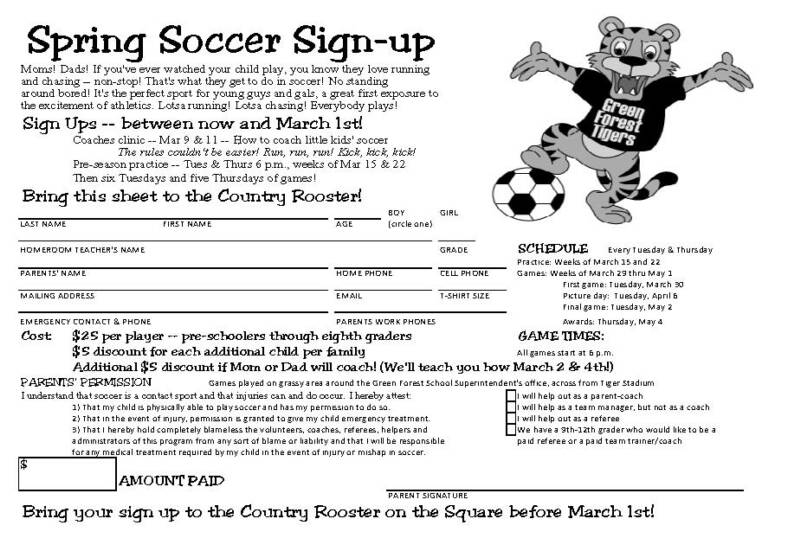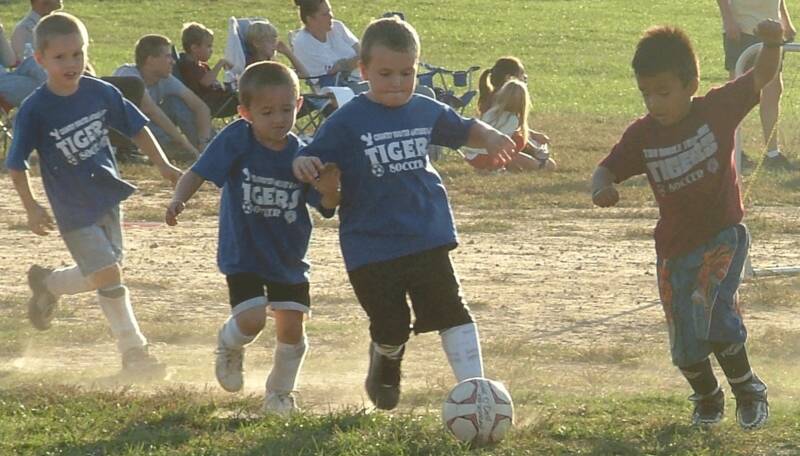THERE ARE 17 LAWS OF THE GAME
Law 1 – The Field of Play

 Fields will be set up for you – but basically a field must be longer than it is wide.
Fields will be set up for you – but basically a field must be longer than it is wide.
Law 2 – The Ball

 Number 4 – but 5 is OK if there’s no Number 4 ball
Number 4 – but 5 is OK if there’s no Number 4 ball
Law 3 – The Number of Players

 We play 4v4, but 5v5 if both coaches agree – 6v6 in the upper age group
We play 4v4, but 5v5 if both coaches agree – 6v6 in the upper age group
Law 4 – The Players' Equipment

 Shirt, socks, shoes, shorts and SHIN GUARDS
Shirt, socks, shoes, shorts and SHIN GUARDS

 Each player must be wearing the proper jersey
Each player must be wearing the proper jersey
Law 5 – The Referee

 Refs, wear your black shirt so we'll know you're the ref
Refs, wear your black shirt so we'll know you're the ref
Law 6 – The Assistant Referees

 We don’t use them
We don’t use them
Law 7 – The Duration of the Match

 Two 20 minute halves.
Two 20 minute halves.


 Listen for beep, put players on the field, do coin toss
Listen for beep, put players on the field, do coin toss



 • a coin is tossed and the team that wins the toss decides which goal it will attack in the first half
• a coin is tossed and the team that wins the toss decides which goal it will attack in the first half



 • the other team takes the kick-off to start the match.
• the other team takes the kick-off to start the match.



 • the team that wins the toss takes the kick-off to start the second half of the match.
• the team that wins the toss takes the kick-off to start the second half of the match.



 • in the second half of the match, the teams change ends and attack the opposite goals.
• in the second half of the match, the teams change ends and attack the opposite goals.


 Kick off when you hear long blast
Kick off when you hear long blast
Law 8 – The Start and Restart of Play

 See the attached list
See the attached list
Law 9 – The Ball In and Out of Play

 The ball is out of play when:
The ball is out of play when:



 • The entire ball is completely across the line
• The entire ball is completely across the line



 • You blow your whistle to stop play
• You blow your whistle to stop play
Law 10 – The Method of Scoring

 The entire ball must be completely across the goal line and inside the goal
The entire ball must be completely across the goal line and inside the goal
Law 11 – Offside

 We don’t use offside for these games
We don’t use offside for these games
Law 12 – Fouls and Misconduct

 See the attached list
See the attached list
Law 13 – Free Kicks

 In these games, we only use direct free kicks except with the oldest group
In these games, we only use direct free kicks except with the oldest group

 See the attached sheet
See the attached sheet
Law 14 – The Penalty Kick

 In these games, we don’t do penalty kicks except with the oldest group
In these games, we don’t do penalty kicks except with the oldest group

 See the attached sheet
See the attached sheet
Law 15 – The Throw-in



 • Both feet on the ground outside the field
• Both feet on the ground outside the field



 • Both hands on the ball, centered over the head
• Both hands on the ball, centered over the head



 • Somebody on the field must touch the ball before a goal can be scored
• Somebody on the field must touch the ball before a goal can be scored
Law 16 – The Goal Kick

 Taken from the goal area line when an attacker kicks the ball off the end of the field
Taken from the goal area line when an attacker kicks the ball off the end of the field

 Must leave the penalty area
Must leave the penalty area
Law 17 – The Corner Kick

 Taken from the corner when the defending team kicks the ball off the end of the field
Taken from the corner when the defending team kicks the ball off the end of the field
HOW TO START OR RESTART PLAY
Kick-off is taken
• at the start of the match
• after a goal has been scored
• at the start of the second half of the match
A goal may be scored directly from the kick-off.
The ball must be stationary on the center mark
• the referee gives a signal
• the ball is in play when it is kicked and moves forward
• the kicker must not touch the ball again until it has touched another player
Dropped ball is taken when you have to stop play but nobody did anything wrong.
The referee drops the ball at the place where it was located when play was stopped, unless play was stopped inside the goal area, in which case the referee drops the ball on the goal area line.
Play restarts when the ball touches the ground.
Direct kick is taken when a foul on the list from the next page is committed. The ref signals by pointing his arm at the goal. A goal can be scored from a direct kick.
 In our games, all fouls result in a direct kick – except in the Under-12/14 group
In our games, all fouls result in a direct kick – except in the Under-12/14 group
Indirect kick is taken when a foul on the list from the next page is committed. The ref signals by pointing his arm straight up at the sky. A goal can only be scored from an indirect kick after it has been touched by a second player.
 In our games, all fouls result in a direct kick – except in the Under-12/14 group
In our games, all fouls result in a direct kick – except in the Under-12/14 group
 No indirect kicks for younger kids
No indirect kicks for younger kids
Penalty kick is taken when a direct kick foul occurs inside the penalty area.
 In our games, all fouls result in a direct kick – except in the Under-12/14 group
In our games, all fouls result in a direct kick – except in the Under-12/14 group
 No penalty kicks for younger kids
No penalty kicks for younger kids
Throw-in is taken by an opponent when the ball is kicked off the side of the field



 • Both feet on the ground outside the field
• Both feet on the ground outside the field



 • both hands on the ball, centered over the head
• both hands on the ball, centered over the head



 • Somebody on the field must touch the ball before a goal can be scored
• Somebody on the field must touch the ball before a goal can be scored
Goal Kick is taken when an attacker kicks the ball off the end of the field



 • Taken from the goal area line
• Taken from the goal area line



 • Must leave the penalty area
• Must leave the penalty area
Corner Kick is taken when the defending team kicks the ball off the end of the field
FOULS AND MISCONDUCT ARE PENALIZED AS FOLLOWS:
Direct free kick fouls
 A direct free kick is awarded to the opposing team if a player commits any of the following seven offences in a manner considered by the referee to be careless, reckless or using excessive force:
A direct free kick is awarded to the opposing team if a player commits any of the following seven offences in a manner considered by the referee to be careless, reckless or using excessive force:



 • kicks or attempts to kick an opponent
• kicks or attempts to kick an opponent



 • trips or attempts to trip an opponent
• trips or attempts to trip an opponent



 • strikes or attempts to strike an opponent
• strikes or attempts to strike an opponent
 A direct free kick is also awarded to the opposing team if a player commits any of the following three offences:
A direct free kick is also awarded to the opposing team if a player commits any of the following three offences:



 • handles the ball deliberately (except for the goalkeeper within his own penalty area)
• handles the ball deliberately (except for the goalkeeper within his own penalty area)
A direct free kick is taken from the place where the offence occurred
Penalty kick fouls
 A penalty kick is awarded if any of the above ten offences is committed by a player inside his own penalty area, irrespective of the position of the ball, provided it is in play.
A penalty kick is awarded if any of the above ten offences is committed by a player inside his own penalty area, irrespective of the position of the ball, provided it is in play.
Indirect free kick fouls
 An indirect free kick is awarded to the opposing team if:
An indirect free kick is awarded to the opposing team if:

 a goalkeeper, inside his own penalty area, commits any of the following four offences:
a goalkeeper, inside his own penalty area, commits any of the following four offences:



 • controls the ball with his hands for more than six seconds before releasing it from his possession
• controls the ball with his hands for more than six seconds before releasing it from his possession



 • touches the ball again with his hands after he has released it from his possession and before it has
• touches the ball again with his hands after he has released it from his possession and before it has



 • touches the ball with his hands after it has been deliberately kicked to him by a team-mate
• touches the ball with his hands after it has been deliberately kicked to him by a team-mate



 • touches the ball with his hands after he has received it directly from a throw-in taken by a team-mate
• touches the ball with his hands after he has received it directly from a throw-in taken by a team-mate

 in the opinion of the referee, a player:
in the opinion of the referee, a player:



 • plays in a dangerous manner
• plays in a dangerous manner



 • impedes the progress of an opponent
• impedes the progress of an opponent



 • prevents the goalkeeper from releasing the ball from his hands
• prevents the goalkeeper from releasing the ball from his hands



 • commits any other offence for which play is stopped to caution or send off a player
• commits any other offence for which play is stopped to caution or send off a player
The indirect free kick is taken from the place where the offence occurred
CARDS
 We don’t give players yellow or red cards.
We don’t give players yellow or red cards.
 However, the referee can warn a player to behave. If the player does not behave, the ref can tell the coach that he is being sent off, but that the coach can send him back in after he sits out a few minutes.
However, the referee can warn a player to behave. If the player does not behave, the ref can tell the coach that he is being sent off, but that the coach can send him back in after he sits out a few minutes.

